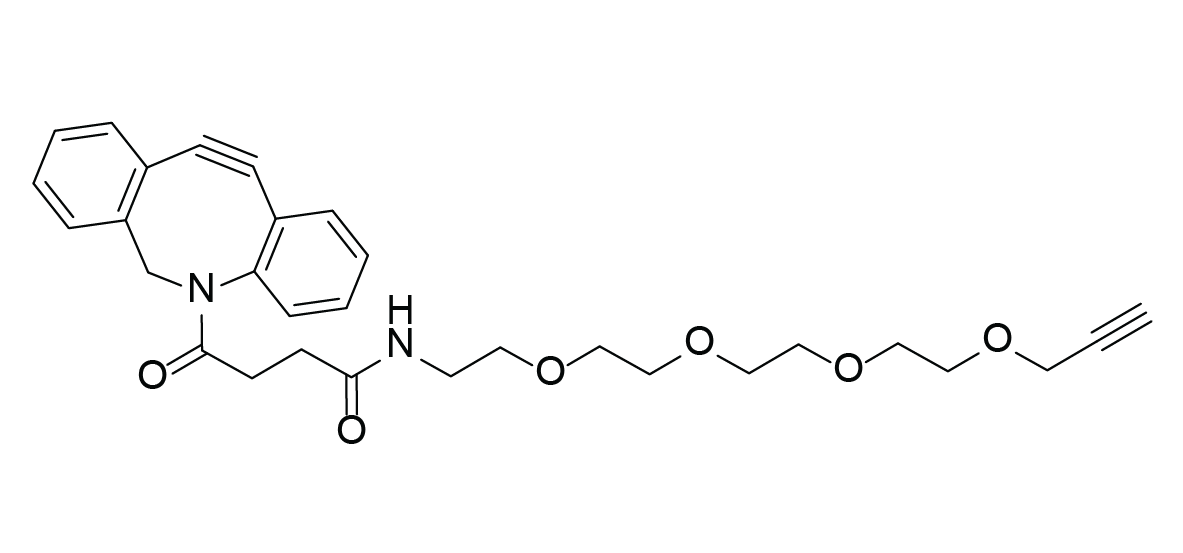DBCO-PEG4-Alkyne
Heterobifunctional Linker for Sequential Click Chemistry in Aqueous Systems

| Size | Catalog No. | Price |
|---|---|---|
| 5 mg | BCL-036-5 | € 120,00 |
| 10 mg | BCL-036-10 | € 190,00 |
Chemical Properties
-
Molecular Formula
C30H34N2O6
-
Shelf Life
12 months unopened after receipt
-
Storage Conditions
-20 °C, dark
-
Molecular Weight
518.24 g/mol
-
Purity
≥ 95% (HPLC)
-
Physical State
slightly yellow oil
-
CAS Number
2741418-16-4
-
Solubility
DCM, THT, Acetonitrile, DMF, DMSO
-
Preparation/Handling
For a 10 mM solution add 965 μL to 5 mg.
For a 10 mM solution add 1930 μL to 10 mg.
Product Information
Heterobifunctional Linker for Sequential Click Chemistry in Aqueous Systems
DBCO‑PEG4‑Alkyne is a heterobifunctional crosslinker combining two orthogonal reactive groups:
- DBCO for copper‑free SPAAC (strain‑promoted azide–alkyne cycloaddition)
- Terminal alkyne for CuAAC (copper‑catalyzed azide–alkyne cycloaddition)
This design enables two sequential click reactions under mild, bioorthogonal conditions, allowing precise molecular assembly without compromising biomolecule integrity. The PEG4 spacer improves solubility in aqueous environments, reduces aggregation, and minimizes steric hindrance—ideal for conjugation in polar systems.
Why DBCO‑PEG4‑Alkyne?
Traditional conjugation methods (e.g., NHS‑ester chemistry) often require harsh conditions, exhibit poor selectivity, and risk damaging sensitive biomolecules. DBCO‑PEG4‑Alkyne overcomes these limitations by leveraging the 2022 Nobel Prize‑winning click chemistry principles for highly selective, efficient, and biocompatible crosslinking.
Key Advantages
- Green Chemistry Approach: Click reactions are atom‑economic, require non‑toxic solvents, and generate minimal waste—making them environmentally friendly and cost‑effective.
- Fast & Efficient: SPAAC and CuAAC form stable triazole linkages quickly and with high yield.
- Orthogonal Reactivity: Enables two distinct click reactions in a controlled sequence for advanced molecular engineering.
- PEG4 Backbone Benefits: Enhances water solubility, reduces steric hindrance, and improves conjugation efficiency in polar environments
Applications
- Antibody–Drug Conjugates (ADCs): Site‑specific dual labeling for targeted therapeutics.
- Crosslinking of Azido‑Modified Molecules: Proteins, peptides, nucleic acids, and polymers.
- Targeted Drug Delivery: Construction of multifunctional conjugates for precision medicine.
LITERATURE
Transient protection of strained alkynes from click reaction via complexation with copper, S. Yoshida et al., 2014, Journal of the American Chemical Society, Vol. 136(39), p. 13590-13593.
https://doi.org/10.1021/ja507660x
Strategies and challenges for the next generation of antibody–drug conjugates, A. Beck et al., 2017, Nature Reviews Drug Discovery, Vol. 16, p. 315–337.

